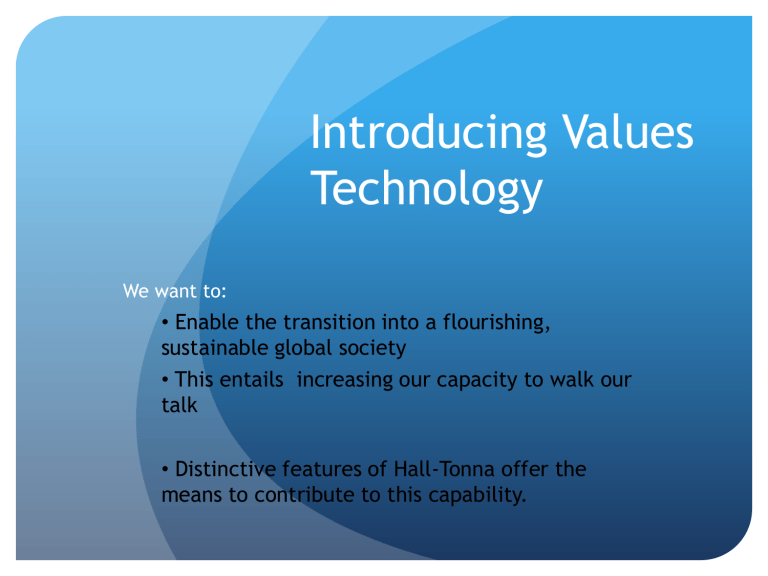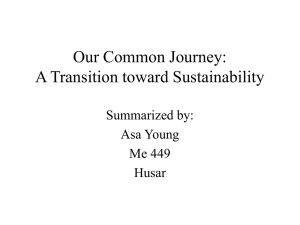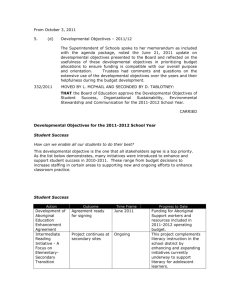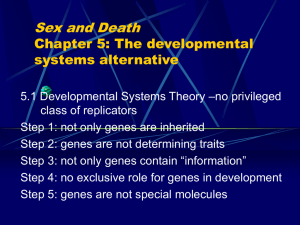VT background

Introducing Values
Technology
We want to:
• Enable the transition into a flourishing, sustainable global society
• This entails increasing our capacity to walk our talk
• Distinctive features of Hall-Tonna offer the means to contribute to this capability.
Multiple ways of illuminating the invisible.
What do we need for this?
Clear definitions of values so that we are talking about the same thing, not only subjective
Appreciation of full range of values, the dynamic of their shift, how they cluster together and what this means
The ability to map the gaps between lived values and aspirational values—those required for sustainability
To be able to know how to move the values towards sustainability (how to promote the ‘great transition’)
A developmental understanding, which includes, what are the pre-requisites to live out aspirational values; dynamics of regression, challenges of communication between different stages of development
For what purpose?
To understand
Ourselves
Others
Our collectivities, including businesses, partners, competitors and multiple stakeholders
What is needed for performance enhancement
To facilitate and create
True communication between different values-perspectives
Transitions
Transformation into sustainability
Values Technology:
Background
Came out of Dr Brian Hall’s work in Latin America and 17 years of research at
Santa Clara University.
With a team of linguists, anthropologists, psychologists and others, he honed definitions of 125 universal human values, a way to map them, a technology to measure them and a practice to move them.
Hall and VT is under-published and not well known.
Defining Values:
Important to mean the same things when we communicate.
Values are priorities expressed in our behaviors. They reflect our worldview.
Values are bridges—they mediate—between our inner and outer worlds.
Values are embedded in language and manifest in behavior. All
relationships, conscious or not, are underpinned by the values priorities we hold in common (in those relationships). We are
always communicating our values.
Values shape and are subsequently shaped by relationships.
Relationships shape the hard and soft structures of all organisations, technologies, and institutions.
The question is not, is an organisation (business) ‘values led’ but does
it know which values it is manifesting – and which values it needs to manifest to achieve its goals?
Distinctive?
A nuanced, developmental perspective
: 1. Developmental: Values build on one another.
An appreciation of transitions—what individuals and organisations have to deal with in order to move through major transitions.
2. Practical Aspects: values are Map-able, Measurable, and
Moveable; applicable and useful to all scales of society.
3. Links values to skills, behaviors, and communication effectiveness
4. Universality, which has significant implications for standardisation, contextual expression, and working across sectors
Ample room for further action-research
Values: Universal or Context-specific?
Values, as ‘pockets of energy’ that mediate our inner and outer worlds, are essential aspects of what it means to be human. Hall-
Tonna attempted to name the inherently un-namable by distinguishing
125 universal human values.
Example: Ecority: Personal Value: the capacity, skills and personal, organizational or conceptual influence to enable persons to take authority for the created order of the world and to enhance its beauty and balance through creative technology in ways that have world-wide influence.
Corporate Value: the capacity, skills and personal, organizational and conceptual influence to enable the business to contribute to global ecological balance through creative technology in ways that have world-wide influence.
Each person and culture’s expression of these values may differ.
Discovering and resonating with one’s values—seeing one’s life stories in values tracks—is a significant ‘ah hah’ moment. Yes, that’s who I am!
How values work (1): Developmental
Values Develop – Development is neither good or bad.
They build on one another. We can imagine this development as a spiral.
Thus, there are Foundational Values, Focus Values and Vision Values.
Thus, they move over the course of our lives and we encounter different contexts – from personal relationships to globalisation.
There is a dynamic of values shift.
There might be gaps that will need to be filled if aspired-to values are to become lived values.
Understanding the developmental trajectory of different tracks enables intervention and action.
Different levels of collective development make different demands demands on communication, leadership and knowledge
Sustainability requires values development.
How values work (2): phases
Elements of World
View
How the world is perceived by the individual
Phase I
A mystery over which I have no control
Phase II
A problem with which I must cope
How the individual functions in the world
Ego is the center of an alien and oppressive environment
Ego seeks to belong by approval of significant others & by succeeding
Human needs the person seeks to satisfy
Physical needs: food, warmth, shelter
Social needs: acceptance, approval, achievement
Types of Values
Goal Values
Means Values
Phase I
Self -
Preservation
Safety
Phase II
Self-Worth
Education
Phase III
A project in which I must participate
Self acts and initiates creatively, independently with conscience
Personal fulfillment: meaning, creativity, insight
Phase III
Self-
Actualization
Independence
Phase IV
A mystery for which we must care
Self acts as
“we” with others to enhance quality of life globally
World community: harmony, by communal action
Phase IV
Truth/Wisdom
Ecority
Convivial
Technology
Values working at work
Useful in businesses for both:
1. What a business’ values’ lived and vision values are – where they actually are.
This impacts: strategy, working with partners, mergers, human resources (esp hiring and firing), communications, team work, how to work with resistance.
This can be done through generating reports at individual and group level and the use of document analysis, individual and systemic reflection, multi-level interviews, coaching, working with institutional structures.
2. Businesses seeking to enable sustainability
Esp partnerships between businesses, NGOs, public sector, etc.
Examples
Tamil Nadu
Using our understanding – are we going ‘forward’ or
‘backward’? What do we need if we are to go forward?
Creating a community of Practice
Processes
Systemic reflection
What is the role of the consultant?
Walking our talk and modeling change
Ethics
Whose values count?
Confidentiality
Dangers – this is powerful stuff!
Action Research – bringing models together, best practices, explore societal shifts
Further implications
Tremendous potential for societal development











